Yesterday, Google announced the roll out of their new +1 button to both organic and paid search results. Whether you want it or not, these new ad annotations are going to appear on your ads when someone has +1’ed. In my April Search Engine Watch column, I explored how Google will come to understand social media and relationships and monetize not just what you’re looking for, but who you are. The article is reposted below. I recommend you read the Q&A with Google towards the bottom in particular. . How Social Media Affects Paid Search The recommendations of our friends and colleagues have always been one of the most influential drivers of sales and the same is true online. Consider the research:
- When asked what sources “influence your decision to use or not use a particular company, brand or product “71% claim reviews from family members or friends exert a “great deal” or “fair amount” of influence. (Harris Interactive, June 2010)
- 90% of consumers online trust recommendations from people they know; 70% trust opinions of unknown users. (Econsultancy, July 2009)
- 53% of people on Twitter recommend companies and/or products in their Tweets, with 48% of them delivering on their intention to buy the product. (ROI Research for Performance, June 2010)
We all have limited time. Relationships are a way to help us quickly figure out what is most relevant and trustworthy. Our friends and the online community are helping us make decisions. Just as you’re more likely to buy from a trusted merchant, you’re also more likely to click on an ad from an advertiser you like or whom your friends like. Google took their first step towards monetizing relationships with the addition of the +1 box on text ads: 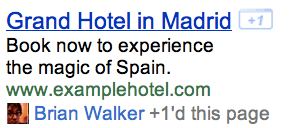 (Source) This is a natural evolution of AdWords. But, it’s only the tip of the iceberg of how social media will impact paid search advertising. Google is starting to monetize not just what you do, but who you are. . Where Google Find Relationships In order for Google to be able to expose information for your network of relationships, they first have to find those relationships. As they say, “We actually do try to map one true person,” Mike Cassidy, Director of Search Product Management, Google said. “The more we can do to associate content to a person, the better,” he added, calling this “AuthorRank.” That’s no small task and it’s complicated by the way people express their relationships online. While we in the tech community are accustomed to creating online networks and participating in communities that mirror our personal relationships, we are the exception to the norm. The landmark research presentation The Real Life Social Network, by current Facebook employee and former Google User Experience Architect Paul Adams, underscores this point with this eye-opening chart:
(Source) This is a natural evolution of AdWords. But, it’s only the tip of the iceberg of how social media will impact paid search advertising. Google is starting to monetize not just what you do, but who you are. . Where Google Find Relationships In order for Google to be able to expose information for your network of relationships, they first have to find those relationships. As they say, “We actually do try to map one true person,” Mike Cassidy, Director of Search Product Management, Google said. “The more we can do to associate content to a person, the better,” he added, calling this “AuthorRank.” That’s no small task and it’s complicated by the way people express their relationships online. While we in the tech community are accustomed to creating online networks and participating in communities that mirror our personal relationships, we are the exception to the norm. The landmark research presentation The Real Life Social Network, by current Facebook employee and former Google User Experience Architect Paul Adams, underscores this point with this eye-opening chart: 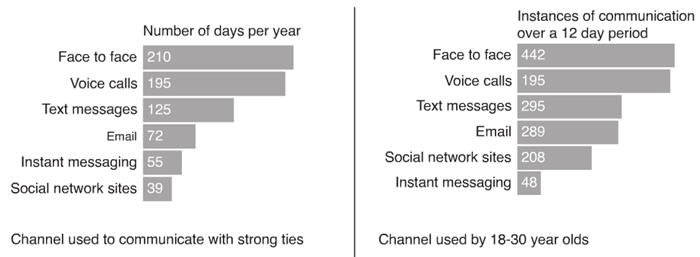 (Source: The Real Life Social Network) While we’re rightfully fascinated with the implications of social media, we are still living in a time where relationships are most frequently created and maintained through more basic mediums, like the phone and email. Think of it as a variation on the 100:10:1 rule, which says that:
(Source: The Real Life Social Network) While we’re rightfully fascinated with the implications of social media, we are still living in a time where relationships are most frequently created and maintained through more basic mediums, like the phone and email. Think of it as a variation on the 100:10:1 rule, which says that:
- 1% of the visitors to a website will create new content or contribute content.
- 10% of the visitors will interact with the content by writing comments or say rating the content.
- The remaining (a very large majority by the way) will merely read the content
We build and express relationships online primarily by communicating and so on down to a minority who will create: 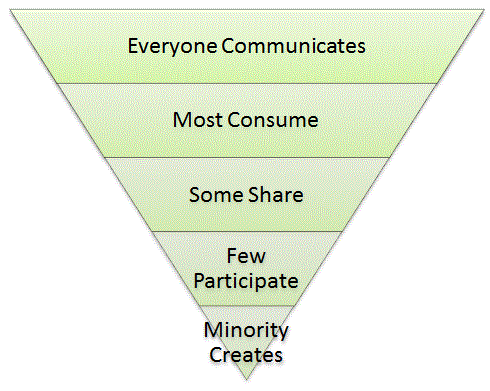 In order to understand relationships, you need to have data. Google has data and it comes from 3 sources:
In order to understand relationships, you need to have data. Google has data and it comes from 3 sources:
- Primary Products
- Secondary Products
- External Accounts
Primary Products are the Google products we use to communicate, namely Google Voice, Gmail and Google Talk (aka chat). What is a better indicator of the people you care about than those whose calls you take and the ones you email and chat with most regularly? Secondary Products include anything from the universe of Google’s free tools where you can share, review, comment or make other kinds of connections, including:
- Explicit social networks, like Buzz, Orkut, and Groups.
- Sites designed around consuming and sharing different kinds of media, like Picasa Web Albums, Google Reader, YouTube, Blogger and Docs.
- Local and mobile networks in Google Places / Hotpot and Latitude.
Our relationships aren’t limited to Google, however, and they’re attempting to connect those relationships to your Google profile by linking External Accounts, or accounts from other services: 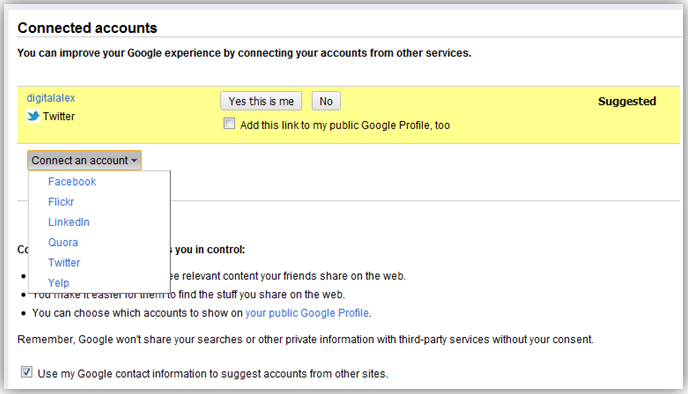 Right now, this includes services from Facebook, Flickr, LinkedIn, Quora, Twitter, and Yelp. But, there is room to expand and some have reported exposing the ability to connect additional networks like MySpace, Foursquare, Digg, Microsoft, and AOL. The result is a network (not called Google Circles) that mixes what Google calls Direct Connections (or strong ties), Secondary Connections, such as friends of friends (or weak ties) and Temporary Ties (such as those with an online reviewer). Establishing that “one true person”, as Cassidy put it through these products and networks is partly done through what people explicitly say about themselves, such as when they link accounts. Google is also inferring relationships based on publicly available data: “If you’re signed in to Google, you may see a message beneath a search result when Google algorithmically detects that a public profile from a social website may be yours. If the profile is yours, you can connect the account to your Google Account to improve the search results that you see.” It looks like this:
Right now, this includes services from Facebook, Flickr, LinkedIn, Quora, Twitter, and Yelp. But, there is room to expand and some have reported exposing the ability to connect additional networks like MySpace, Foursquare, Digg, Microsoft, and AOL. The result is a network (not called Google Circles) that mixes what Google calls Direct Connections (or strong ties), Secondary Connections, such as friends of friends (or weak ties) and Temporary Ties (such as those with an online reviewer). Establishing that “one true person”, as Cassidy put it through these products and networks is partly done through what people explicitly say about themselves, such as when they link accounts. Google is also inferring relationships based on publicly available data: “If you’re signed in to Google, you may see a message beneath a search result when Google algorithmically detects that a public profile from a social website may be yours. If the profile is yours, you can connect the account to your Google Account to improve the search results that you see.” It looks like this:  In that case, the relationship is inferred and confirmed. They’re also learning about relationships based on based on usage data that is not explicitly stated or even confirmed. Take the Priority Inbox feature from Gmail, for example: To predict which of your incoming messages are important, Gmail automatically takes into account a number of signals, including:
In that case, the relationship is inferred and confirmed. They’re also learning about relationships based on based on usage data that is not explicitly stated or even confirmed. Take the Priority Inbox feature from Gmail, for example: To predict which of your incoming messages are important, Gmail automatically takes into account a number of signals, including:
- Who you email (For example, if you email Bob a lot, it’s likely that messages from Bob are important.)
- Which messages you open (Messages you open are likely more important than those you skip over.)
- What keywords spark your interest (If you always read messages about soccer, a new message that contains those same soccer words is more likely to be important.)
- Which messages you reply to (If you always reply to messages from your mom, messages she sends you are likely to be important.)
- Your recent use of stars, archive and delete (Messages you star are probably more important than messages you archive without opening.)
While I mentioned Google Voice in the beginning of this section, it’s worth noting that neither +1’s nor Social Search features make use of those data yet. The collective data about who you are means ads that reflect not just what you do (search), but who you are. . How Google Monetizes Relationships Google is a publisher. Their content is search results pages and inventory on the display network. Their goal is to maximize their yield for the ads they use to monetize that content. To do that, Google incorporates a variety of signals based on what you’re looking for and what you’re likely to respond to. What you’re looking for, as expressed by your search query, is by far the greatest signal of your intent. One of the strongest indicators of the best possible answer for what you’re looking for is what others have responded to, based on past query/keyword/text ad performance. When it comes to the Display Network, they also look at what you’re interested in, as expressed by your actions on sites (e.g. Interest based ads) and demographics. Relationships are a relatively new addition to the signals used to maximize yield, but they’re based on two old tools of influence: Social Proof and Liking.
- Social Proof – People will do things that they see other people are doing
- Liking – People are easily persuaded by other people that they like
These principles are well documented in Dr. Robert Cialdini’s fascinating book, Influence: The Psychology of Persuasion. The interaction of relationships with social proof and liking creates ways for Google to monetize based on the implicit and explicit data from those relationships:
- Implicit: Identify preferences based on relationships; monetize the preferences
- Explicit: Incent people to take some action their network can see; monetize the actions
Right now, they’re looking at:
- Endorsements from who you’re closest to, i.e. Direct Connections
- What others like or say, i.e. Secondary Connections and social proof from weak ties
They’re social extensions for your ads. Social Extensions in Paid Search Since the summer of last year, AdWords has automatically included a social feature called seller rating extensions on all eligible ads. It appends aggregated reviews and stars (ratings) from Google Product Search:
Seller ratings extensions are applied automatically and you can’t opt-out. Two weeks ago, Google introduced the “+ 1” button, their version of a Facebook like. While it’s primarily for spreading content socially within the organic results, +1’s will be available for text ads as well. The result is a new 5th line with photo and endorsement. 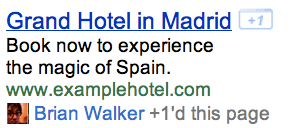 Like seller ratings extensions, +1 buttons will eventually show up near all ads and +1’s will be applied automatically without the option to turn them off. Potential Future Social Extensions I think local and mobile searches have the greatest short-term potential for Google’s social extensions in paid search. Consider this interesting statistic from Marissa Mayer, Vice President of Location and Local Services at Google: “She pointed to the fact that 20% of all Google searches are for local information.” This presents an opportunity for monetizing relationships around business reviews and product reviews. Google is already including relationships in organic social search results, as is the case with Google Hotpot recommendations:
Like seller ratings extensions, +1 buttons will eventually show up near all ads and +1’s will be applied automatically without the option to turn them off. Potential Future Social Extensions I think local and mobile searches have the greatest short-term potential for Google’s social extensions in paid search. Consider this interesting statistic from Marissa Mayer, Vice President of Location and Local Services at Google: “She pointed to the fact that 20% of all Google searches are for local information.” This presents an opportunity for monetizing relationships around business reviews and product reviews. Google is already including relationships in organic social search results, as is the case with Google Hotpot recommendations: 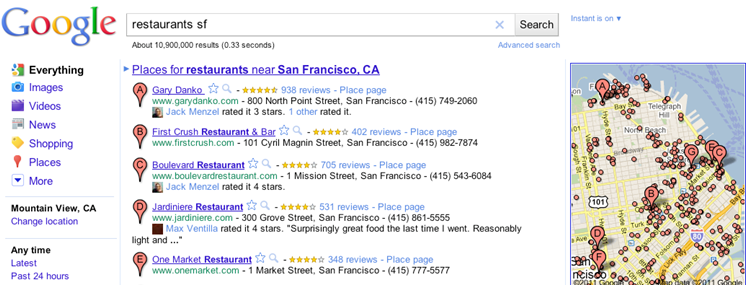 Adding social extensions related to review for geo-targeted ads, similar to how they currently append a location, or Google Boost would be a natural fit. Similarly, mobile searches are even more local: • 53% of mobile searches on Bing have a local intent • “1 in 3 queries from smartphones are about where I am.” Eric Schmidt – CEO, Google This fact hasn’t been lost on Google, which introduced check-ins and offers on Google Latitude. I wouldn’t be surprised to see Latitude be renamed Google Places Mobile and for check-ins, +1’s and reviews from mobile to spread across social search results, both paid and organic. Preferences Based on Relationships In any discussion of social media and paid search, it’s worth noting the new Gmail ad targeting that Google is rolling out: Soon we’re going to try a similar approach to ads: using some of the same signals that help predict which messages are likely to be important to you, Gmail will better predict which ads may be useful to you. For example, if you’ve recently received a lot of messages about photography or cameras, a deal from a local camera store might be interesting. On the other hand if you’ve reported these messages as spam, you probably don’t want to see that deal. They’re not clear on which of the signals they us. I suspect they’re looking at keywords in text messages (since AdWords and the Display Network is primarily text driven) and which commercial emails you open, essentially creating an Interest or Topic based profile for you based on email activity. Gmail fall into the Display Network, not strictly paid search, but ad buys targeted at that placement are also managed through AdWords and 3rd party tools. . What Social Media Means for Paid Search Marketers As paid search advertisers, we’re fundamentally trying to as efficient as possible and narrowly targeted relevance is the easiest way to do that. In AdWords, relevance is still primarily defined by someone’s search query (intent), but that is still only one of many signals, which include who searchers are:
Adding social extensions related to review for geo-targeted ads, similar to how they currently append a location, or Google Boost would be a natural fit. Similarly, mobile searches are even more local: • 53% of mobile searches on Bing have a local intent • “1 in 3 queries from smartphones are about where I am.” Eric Schmidt – CEO, Google This fact hasn’t been lost on Google, which introduced check-ins and offers on Google Latitude. I wouldn’t be surprised to see Latitude be renamed Google Places Mobile and for check-ins, +1’s and reviews from mobile to spread across social search results, both paid and organic. Preferences Based on Relationships In any discussion of social media and paid search, it’s worth noting the new Gmail ad targeting that Google is rolling out: Soon we’re going to try a similar approach to ads: using some of the same signals that help predict which messages are likely to be important to you, Gmail will better predict which ads may be useful to you. For example, if you’ve recently received a lot of messages about photography or cameras, a deal from a local camera store might be interesting. On the other hand if you’ve reported these messages as spam, you probably don’t want to see that deal. They’re not clear on which of the signals they us. I suspect they’re looking at keywords in text messages (since AdWords and the Display Network is primarily text driven) and which commercial emails you open, essentially creating an Interest or Topic based profile for you based on email activity. Gmail fall into the Display Network, not strictly paid search, but ad buys targeted at that placement are also managed through AdWords and 3rd party tools. . What Social Media Means for Paid Search Marketers As paid search advertisers, we’re fundamentally trying to as efficient as possible and narrowly targeted relevance is the easiest way to do that. In AdWords, relevance is still primarily defined by someone’s search query (intent), but that is still only one of many signals, which include who searchers are:  At the end of the day, having lots of +1’s is not going to save a crappy ad, a bad landing page, irrelevant text or a bad offer. It’s also not going to fix bad targeting. The fundamentals of paid search are still the most important part of a successful campaign. Specific to +1, Google’s PR team answered some of my questions in Jonathan Allen’s coverage of the announcement.
At the end of the day, having lots of +1’s is not going to save a crappy ad, a bad landing page, irrelevant text or a bad offer. It’s also not going to fix bad targeting. The fundamentals of paid search are still the most important part of a successful campaign. Specific to +1, Google’s PR team answered some of my questions in Jonathan Allen’s coverage of the announcement.
- How will +1 on ads impact Quality Score? +1 does not change how we calculate Quality Score. As always, we look at an ad’s performance relative to that of other ads for the same query, position, and UI treatment. However, while advertiser performance will of course vary, we believe that +1’s may increase CTR, which would positively affect high quality ads.
- Will advertisers ever be able to opt-out of it? The +1 button and personalized annotations are the default experiences for all signed-in Google.com users searching in US English. If advertisers have a serious concern about these features, they can submit this form for our review.
- Will +1 only apply to text ads, or will it also be available on Display Network text and image ads and on new ad formats such as product listing ads, product extensions, and Media Ads? We’re certainly looking at how the +1 button can add user value for lots of different types of ads, but don’t have anything to announce just yet.
- Will +1 shares on landing pages impact the landing page component of Quality Score? No.
- Will +1 votes on products or landing pages impact the bidding algorithm for products that rely on prediction of conversion rate, such as Enhanced CPC? No.
I appreciate Google’s answers. Next, they need to give advertisers greater control over when and how social extensions are applied to their ads. Right now, it’s a fifth line of advertising automatically controlled by Google. Reporting and analytics should communicate when our ads included +1 and how that impacted performance. While I’ll concede Google’s decision to opt advertisers into the program to increase the adoption of +1, we do need the option to turn it on or off. Just as relationships are nuanced, the way relationships affect paid search will be nuanced. As Paul Adams points out in his presentation:
- Not every social connection has equal weight
- Not every social connection is useful for the same information
Maximizing relevance with social extensions means accounting for those differences. Social media is founded on relationship. Relationships help us discover new things, remove risk from our decisions and affirm our choices. Paid search advertising is about satisfying intent as efficiently as possible and this is a new layer to that goal.




